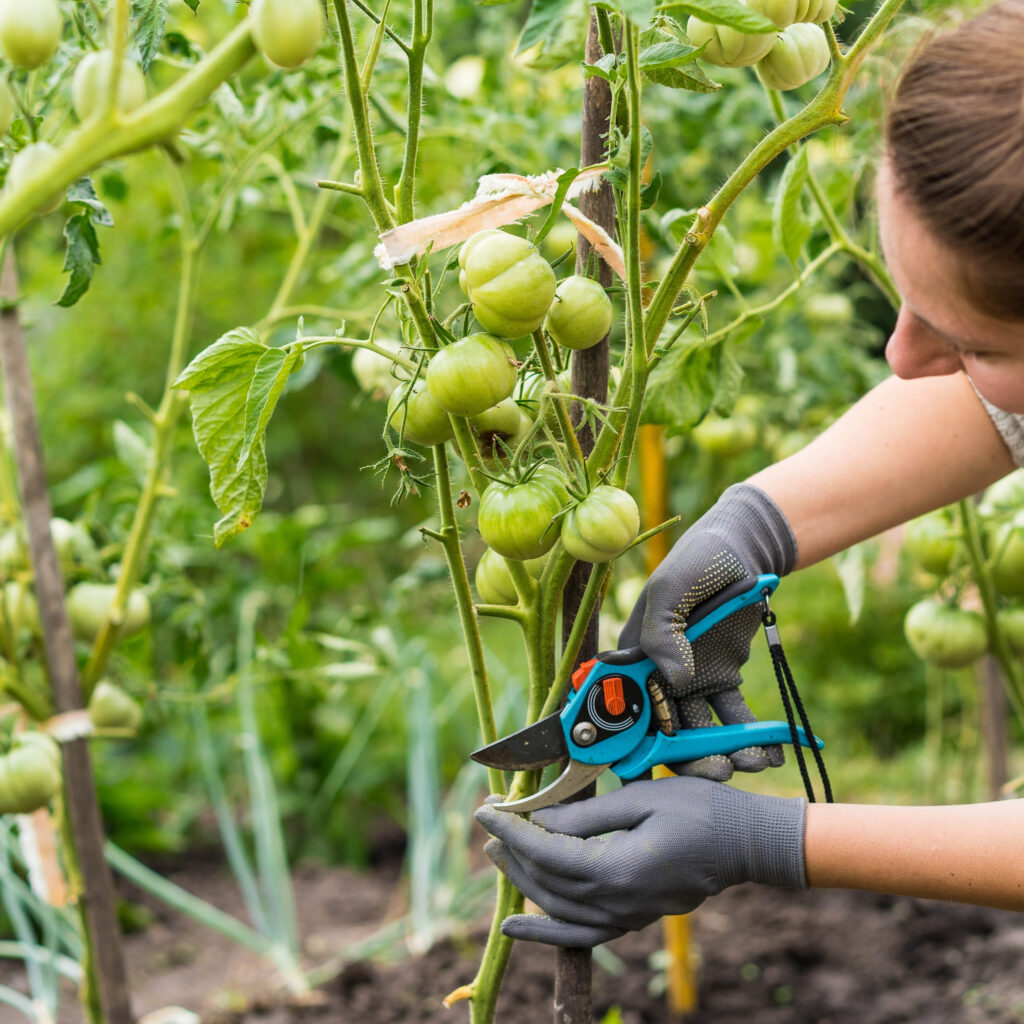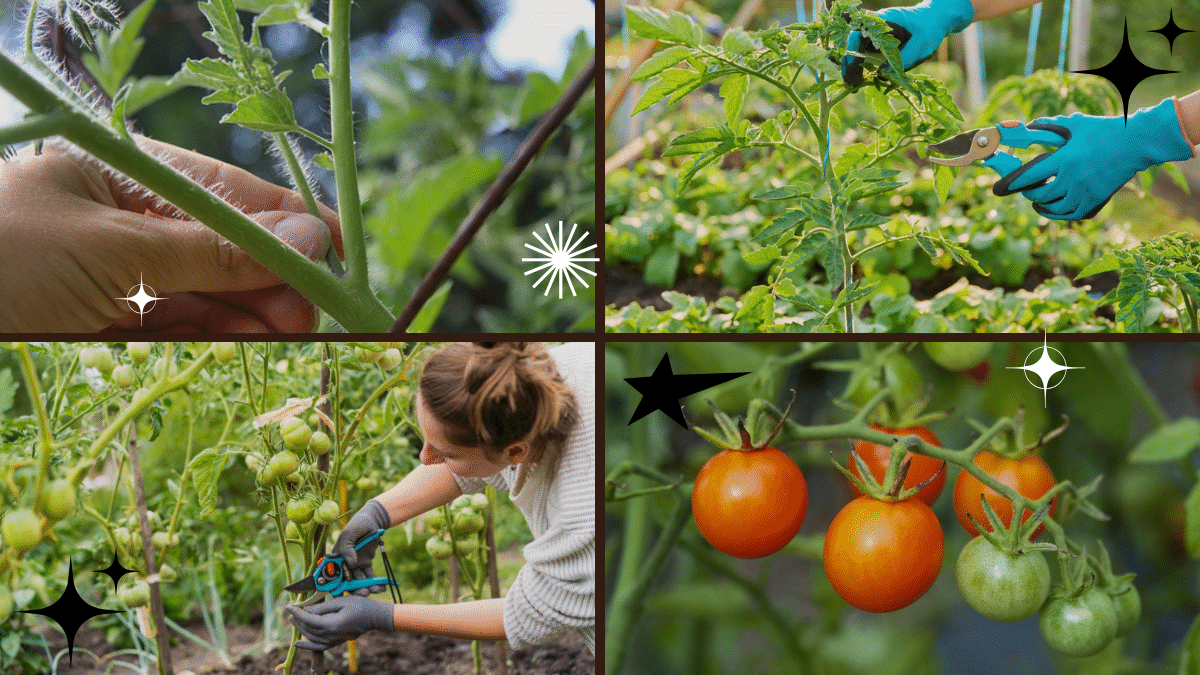Tomatoes are among the most popular and rewarding plants to grow in home gardens. Whether you’re after juicy slicing tomatoes, tangy cherry varieties, or meaty paste types, a bit of care and attention can dramatically improve your harvest. One of the most effective ways to boost your tomato yield and plant health is through proper pruning.
Many beginner gardeners wonder if pruning is truly necessary — and the answer is a confident yes for certain types of tomato plants. Done correctly, pruning not only improves airflow and reduces disease but also encourages stronger, more productive plants.
In this comprehensive guide, we’ll cover everything you need to know about how to prune a tomato plant for better growth — including why it matters, when to do it, what tools you’ll need, and a step-by-step method you can follow today.

Why Should You Prune Tomato Plants?
Pruning is the process of selectively removing certain parts of a plant — typically stems, leaves, and suckers — to direct energy toward fruit production rather than excessive foliage growth. Let’s explore the key benefits of pruning tomato plants:
Better Air Circulation
Dense foliage traps moisture, creating the perfect environment for fungal diseases like blight and powdery mildew. Pruning improves airflow and reduces disease risk.
Higher-Quality Fruits
Pruning directs the plant’s resources to fewer, more robust fruits rather than lots of smaller, less flavorful tomatoes.
Faster Ripening
With less foliage shading the plant, sunlight reaches the fruits more directly, helping them ripen evenly and quickly.
Easier Maintenance and Harvesting
A pruned plant is tidier, making it easier to water, check for pests, and pick ripe tomatoes.

Determinate vs. Indeterminate Tomatoes: Know the Difference
Before you start pruning, it’s crucial to understand what type of tomato plant you’re working with, as pruning practices differ.
Determinate (Bush) Tomatoes:
- Grow to a fixed height (about 3-4 feet).
- Produce most of their fruit over a short period.
- Minimal pruning is recommended — only remove dead or diseased leaves.
Indeterminate (Vining) Tomatoes:
- Keep growing and producing fruit throughout the season.
- Can reach 6-10 feet tall or more.
- Benefit greatly from regular pruning.
This article focuses primarily on pruning indeterminate tomatoes, but we’ll mention light maintenance tips for determinate varieties too.

When Should You Prune Tomato Plants?
The best time to start pruning is when your tomato plant reaches 12-18 inches tall and begins producing side shoots or “suckers.”
Ideal pruning time:
- In the early morning on a dry, sunny day.
This reduces stress on the plant and minimizes disease risk, as cuts heal faster in dry conditions.
Continue pruning every 7-10 days throughout the growing season for indeterminate varieties.

What Tools Do You Need for Pruning?
Keeping your tools clean and sharp is essential to avoid spreading plant diseases.
Recommended tools:
- Sharp garden shears or pruning scissors
- Garden gloves
- Rubbing alcohol or a disinfectant spray (to sanitize tools between plants)
For small suckers, you can also use your fingers to pinch them off cleanly.
How to Prune a Tomato Plant: Step-by-Step Guide
Let’s break down the pruning process into clear, manageable steps.
Step 1: Identify the Suckers
Suckers are small shoots that grow from the junction (called the leaf axil) between a branch and the main stem.
They typically appear as small, leafy growths and will eventually turn into full branches if left unchecked. On indeterminate tomatoes, these suckers can overrun the plant and sap energy away from fruit production.
Step 2: Remove Lower Leaves
Start by removing any leaves or branches below the first flower cluster. These lower leaves are more prone to soil splashing, pests, and fungal infections.
Use clean scissors or gently pinch them off.
Step 3: Pinch Off Small Suckers
Once your plant starts producing suckers (usually about 6-8 inches tall), pinch off the small ones with your fingers while they’re tender and easy to remove.
Important Tip:
Leave suckers above the topmost flower cluster if you want to continue extending the vine.
Step 4: Decide on a Pruning Style
You can choose one of several pruning strategies, depending on how much growth you want to allow:
- Single-Stem Pruning:
Keep one main stem and remove all suckers. This method is ideal for limited space and supports early fruiting. - Two-Stem Pruning:
Allow the main stem and one additional sucker (usually the one just below the first flower cluster) to grow. Remove all other suckers. - Three-Stem Pruning:
Allow the main stem and two strong suckers to grow. This method balances fruit production with plant vigor.
Step 5: Top the Plant (Optional)
Toward the end of the growing season, you can top indeterminate tomato plants by cutting off the growing tip of the main stem about 1-2 feet above the highest flower cluster.
This stops new growth, forcing the plant to direct its energy into ripening existing fruits.
Pruning Determinate Tomatoes
For determinate (bush) tomato varieties:
- Only remove dead, yellowing, or diseased leaves.
- Avoid removing suckers, as this can reduce your harvest.
- A light trim to improve airflow is fine, but heavy pruning is unnecessary and often harmful.
Common Pruning Mistakes to Avoid
Even experienced gardeners can make mistakes when pruning tomatoes. Here’s what to watch out for:
- Over-pruning:
Removing too much foliage reduces photosynthesis and stresses the plant. - Pruning during wet weather:
Moisture increases the risk of fungal infection at cut sites. - Using dirty tools:
Always sanitize shears between plants to prevent disease spread. - Pruning determinate varieties excessively:
This can dramatically reduce your harvest.
Frequently Asked Questions
Q: Can I prune tomato plants after they start flowering?
Yes — in fact, it’s common to continue pruning throughout the season. Focus on removing suckers and lower leaves while leaving flower clusters and fruit untouched.
Q: Should I prune the leaves around ripening tomatoes?
You can remove a few leaves shading the fruit to increase sun exposure for faster ripening, but avoid stripping too many, as leaves protect against sunscald.
Q: What if I forgot to prune my tomatoes early?
It’s never too late to start. Remove small suckers and damaged leaves anytime, but be cautious not to shock the plant by removing too much at once.
Conclusion
Pruning tomato plants isn’t just for appearance — it plays a vital role in promoting stronger growth, reducing disease, and producing larger, healthier fruit. While determinate (bush) tomatoes require minimal pruning, indeterminate (vining) varieties thrive with regular attention.
By following the simple, step-by-step guide we’ve outlined here, you’ll enjoy a tidier garden, a more productive harvest, and healthier tomato plants all season long.
So grab those garden shears, keep an eye out for those pesky suckers, and watch your tomato crop flourish like never before!





Leave A Comment